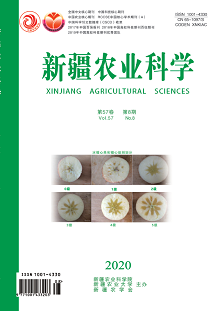|
|
Effect of Chlorpromazine on Sugar Accumulation and Yield Formation of Sugar Beet
PAN Jinghai, Abdukadier Kurban, LIU Huajun, YANG Hongze, LI Jinhu, Ilidarjiang Ablimiti, ZHANG Bao
2020, 57(8):
1411-1420.
DOI: 10.6048/j.issn.1001-4330.2020.08.005
【Objective】 To select the suitable application times of chlorpromazine for beet sugar accumulation and yield formation.【Methods】 The KWS-9147 sugar beet variety was used as the test material, and a quanquat solution (50%) was selected. The field random design was used, and 4 treatments were set, and the quanquat was sprayed 0 times (CK) and once at different times. (D1), 2 times (D2), and 3 times (D3). The effects of spraying chlormequat on the characteristics of sugar beet plants, dynamic changes of sugar accumulation, sugar accumulation response to meteorological factors, and yield formation were studied.【Results】 Spraying chlormequat 3 (D3) and 2 (D2) treatments reduced the beet plant height and dead leaf number by 19.77%, 11.24%, 17.52%, and 17.44%, respectively, compared to CK treatment; root length and root diameter increased 26.37%, 19.90%, 10.37%, 5.93% respectively; and the sweet menu root weight and sugar content increased by 16.54%, 13.38%, 6.60%, and 5.95%, respectively, so that the yield of sugar beet and the yield of sugar increased respectively. It reached 12.69%, 8.90%, 20.17% and 15.35%. There was no significant difference between D2 and D3 treatments (P> 0.05). The dynamic changes of sugar accumulation in D2 treatment coincided with the dynamic changes of local accumulated temperature and daily average temperature, and the fitted values were 0.985,4 and 0.898,6, respectively.【Conclusion】 Two times of treatment (D2) effectively promoted the formation of sugar content and relatively high sugar content in sugar beet in Kashi, southern Xinjiang.
|

